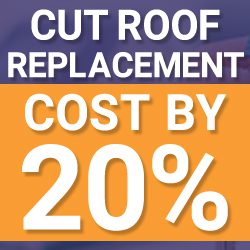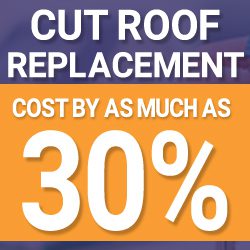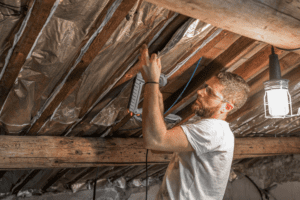Understanding Home Insulation and How It Impacts Your Home
When we think of a cozy home, warm blankets and steamy cups of tea might spring to mind. However, the unsung hero of our comfort is something hidden in the walls, floors, and above our heads: insulation. It’s the barrier that keeps the chill of winter and the heat of summer at bay. Interestingly, a well-insulated home starts with a well-maintained roof, which can prevent significant heat loss. Let’s unwrap the layers of home insulation and understand how it contributes to a more energy-efficient and comfortable living space.
The Science of Insulation
Insulation’s primary job is to slow down the transfer of heat. In the winter, it traps warmth inside; in the summer, it helps keep the heat out. The effectiveness of insulation is measured by its R-value – a higher R-value means greater resistance to the movement of heat.
Understanding the science of home insulation requires a dive into the basics of heat flow, which involves three fundamental processes: conduction, convection, and radiation. Insulation works by slowing down all three forms of heat transfer, which is why it’s a critical component in maintaining a home’s temperature.
Conduction
This is the process by which heat moves through materials. Think of a metal spoon heating up in a pot of hot soup; that’s conduction at work. In homes, heat tries to escape through walls, ceilings, and floors to the cooler outside during winter and vice versa during summer. Insulation, with its resistance to thermal conductivity, provides a barrier that reduces the speed of this heat flow.
Convection
Convection occurs when heat is carried through fluids, which in the case of homes, is typically the air. Warm air rises and cold air sinks, which can lead to a cycle of air movement that naturally wants to even out the temperature in a space. Insulation traps pockets of air and minimizes the convective air movement within the walls and between floors, helping maintain a consistent temperature throughout the home.
Radiation
Radiant heat transfer is the emission of heat in the form of infrared radiation. It’s the warmth you feel when you stand next to a hot stove or under the sun. Reflective insulation with shiny foil faces the heat source and reflects radiant heat away, reducing the radiant heat transfer into or out of the home.

How Insulation Materials Work
The effectiveness of an insulating material to reduce heat flow is measured by its R-value. The R-value is indicative of how well the material resists the passage of heat. The higher the R-value, the better the insulation’s effectiveness.
Insulating materials work because they trap tiny pockets of air within their structure. Air is a poor conductor of heat and when trapped, significantly slows the transfer of heat through conduction. The small pockets also minimize air movement within them, reducing convection. The bulky nature of some materials, like fiberglass or cellulose, can cover large areas and prevent the internal air currents that transfer heat by convection.
Smart Installation for Maximum Efficiency
For insulation to work effectively, it must be installed correctly. Gaps, holes, or compression can drastically reduce the material’s insulating properties. The installation process often requires precision—cutting the material to fit snugly around obstructions, ensuring a continuous barrier without thermal bridges, which are pathways of least resistance where heat can pass through.
Types of Insulation
Insulation is a key factor in a home’s energy efficiency and comfort. There are various types of insulation, each with its unique properties and applications. Here’s an overview of the most common types of insulation you might find in your home:
Fiberglass Insulation
Fiberglass is one of the most ubiquitous types of insulation. It’s made from fine strands of glass woven together and is often found in blanket form (batts and rolls), loose-fill, or rigid board. It’s suitable for insulating walls, floors, attics, and ducts. Fiberglass insulation is relatively inexpensive and has an R-value ranging from R-2.9 to R-3.8 per inch of thickness. While it’s easy to install, improper handling can cause skin irritation and respiratory issues, so protective gear is necessary during installation.
Cellulose Insulation
Made from recycled paper products, cellulose is an eco-friendly insulation option. It’s treated with fire retardants and can be used as loose-fill or blown into walls and attics. With an R-value of about R-3.1 to R-3.8 per inch, cellulose is a good thermal and sound barrier. It is particularly effective for retrofitting older homes because it can be installed without disturbing finished areas.
Spray Foam Insulation
Spray foam insulation is a more modern solution that comes in open-cell or closed-cell variants, with closed-cell providing a higher R-value of around R-6.0 to R-6.5 per inch compared to open-cell’s R-3.5 per inch. It expands to fill cavities and can seal air leaks. Due to its expansion properties, it’s excellent for irregular or hard-to-reach spaces. It’s more expensive than fiberglass or cellulose but offers superior air sealing and moisture resistance.



Rigid Foam Insulation
Rigid foam boards (extruded polystyrene, expanded polystyrene, and polyisocyanurate) are dense, durable insulating materials with high R-values per inch (R-4 to R-6.5). They can be used for insulating walls, roofs, and foundations, both on interior and exterior applications. Rigid foam insulation is more expensive than fiberglass and cellulose but provides continuous insulation with few thermal bridges.
Mineral Wool Insulation
Also known as rock wool or slag wool, mineral wool insulation is made from rock, furnace slag, and other raw materials. It comes in batts, rolls, or loose-fill forms and offers a higher R-value than fiberglass, around R-3.0 to R-3.3 per inch. It is also fire-resistant and excellent at soundproofing.
Reflective Insulation and Radiant Barriers
These materials are designed to reflect radiant heat rather than slowing conduction like other types of insulation. They are generally made of aluminum foil attached to paper or plastic and are most effective in reducing summer heat gain, particularly in attics.
Natural and Sustainable Options
There are also natural insulation materials like wool, cotton (denim), and hemp insulation, which are growing in popularity due to their sustainability and reduced chemical treatments. Their R-values are comparable to traditional materials, but they often come at a higher cost.
Effectiveness and Suitability
The effectiveness of each insulation type is determined by its R-value and the specific needs of the part of the home being insulated. For instance, spray foam may be more appropriate for sealing air leaks and insulating irregular spaces, while fiberglass may be the most cost-effective solution for large, accessible areas like attics.
Climate also plays a role in determining the best type of insulation. In colder climates, higher R-value materials like spray foam or mineral wool may be preferred, while in warmer climates, reflective insulation might be the choice for reducing cooling costs.
Ultimately, the best type of insulation for your home depends on various factors, including the area being insulated, the climate, your budget, and your sustainability preferences. Professional energy auditors can assess your home and recommend the most suitable insulation type for improving energy efficiency and comfort.



Benefits of Proper Insulation
Proper insulation is an essential component of any home, providing a multitude of benefits that go beyond just keeping your living space comfortable. Here’s a look at the multifaceted advantages of having adequate insulation:
Enhanced Comfort
Insulation works to stabilize your home’s internal environment by slowing the transfer of heat. In the winter, it traps warmth inside, and in the summer, it helps keep the heat out, ensuring that your living spaces maintain a consistent and comfortable temperature year-round.
Energy Savings
By maintaining a more consistent internal temperature, insulation reduces the need for heating and cooling systems to work overtime. This efficiency translates directly into energy savings, as less power is required to heat or cool your home, leading to lower utility bills.
Environmental Impact
Reduced energy consumption isn’t just good for your wallet—it’s also good for the planet. By using less energy, you decrease the demand on power plants and the subsequent greenhouse gas emissions they produce. This makes insulation an eco-friendly choice.
Soundproofing
Insulation also acts as a sound barrier, absorbing noises from both outside and inside the home. Dense materials such as spray foam or mineral wool are particularly effective at sound dampening, making your home quieter and more serene.
Moisture Control
Some types of insulation, especially spray foam, can help seal your home against moisture. This is crucial because excessive dampness can lead to mold growth, wood rot, and a host of other issues that can compromise the structure of your home and the health of its inhabitants.



Improved Indoor Air Quality
By preventing the infiltration of outdoor pollutants, proper insulation contributes to better indoor air quality. It can limit the entry of dust, pollen, and other airborne contaminants, making the air inside your home cleaner and healthier to breathe.
Protection Against Ice Dams
In cold climates, insulation combined with proper ventilation helps prevent ice dams on the roof. These occur when heat escapes through the roof, melting the snow which then refreezes at the eaves, potentially causing damage. Adequate insulation reduces the heat escape that leads to this process.
Increased Home Value
Homes with good insulation are more attractive to buyers because they promise comfort and energy efficiency. As such, investing in proper insulation can boost the overall value of your property.
Longer HVAC Lifespan
With proper insulation, heating and cooling systems do not have to work as hard and can thus enjoy a longer operational lifespan. This can save you money on maintenance and replacements in the long run.
Uniform Temperatures Throughout the Home
Proper insulation helps eliminate cold spots and drafts in your home, ensuring that every room feels as warm or cool as the next. This uniform distribution of temperature contributes to a more pleasant living environment.
By protecting against the elements, reducing energy costs, and improving the overall comfort of your living space, proper insulation is a crucial aspect of home maintenance. Moreover, with the increasing emphasis on sustainability and energy efficiency, ensuring that your home is well-insulated is not just a matter of personal comfort, but also of environmental responsibility.



Installation Tips
Installing insulation in your home can be a straightforward process if you follow some essential tips. Whether you are tackling the project yourself or hiring professionals, understanding the key aspects of installation can help ensure that your insulation is effective and durable. Here are some installation tips to consider:
Understand R-Values
Before you begin, it’s important to understand the R-value you need for your climate and the part of the home you’re insulating. The R-value measures the material’s resistance to heat flow, with higher numbers indicating greater insulating power. Check the recommendations for your area to ensure you are achieving the necessary thermal resistance.
Choose the Right Insulation Type
Different areas of your home may require different types of insulation. For example, batts might be appropriate for the attic, while rigid foam boards could be better for exterior walls. Consider factors such as space, moisture, and whether the area needs to be fire-resistant when selecting insulation.
Seal Air Leaks First
Before adding new insulation, seal up any air leaks. This might include gaps around doors, windows, plumbing vents, or electrical boxes. Use caulk, spray foam, or weather-stripping as appropriate. Sealing leaks ensures that your insulation performs optimally.
Wear Protective Gear
When handling insulation, always wear protective gear. This includes a mask, goggles, gloves, and long sleeves. Some insulation materials can irritate the skin, eyes, and lungs, so it’s essential to protect yourself during installation.
Do Not Compress Insulation
For insulation to maintain its R-value, it must not be compressed. This means cutting batts to fit snugly rather than forcing them into spaces. Compressed insulation loses its effectiveness, so take care to fit it properly.



Pay Attention to Vapor Barriers
Vapor barriers prevent moisture from passing through walls and ceilings, which can reduce the effectiveness of insulation and cause structural issues. Make sure the vapor barrier is installed on the warm side of the insulation—inside in cold climates and outside in hot climates.
Ensure Proper Ventilation
Especially in attics, proper ventilation should be maintained to prevent the buildup of moisture. Do not block soffit vents with insulation, and consider installing rafter vents to keep air flowing properly.
Check Local Building Codes
Local building codes may have specific requirements for insulation. These codes can dictate everything from the R-value to the method of installation. Always check these requirements before starting your project to ensure compliance.
Consider Professional Installation for Certain Types
While some types of insulation are relatively DIY-friendly, such as fiberglass batts or rolls, other types, like spray foam, are best left to professionals. The equipment and expertise required for these materials typically surpass what most DIYers have.
Inspect and Assess Old Insulation
If you are adding new insulation to existing material, inspect the old insulation for any signs of moisture, mold, or pest infestation. Remove and replace any compromised insulation before adding new layers.
By following these tips, you can maximize the benefits of insulation in your home. Proper installation is key to ensuring that your home is comfortable, energy-efficient, and structurally sound for years to come. If you’re ever in doubt, don’t hesitate to consult with or hire a professional to ensure the job is done correctly.



Maintenance and Upgrades
Insulation doesn’t last forever. If your energy bills are creeping up or you notice drafts and uneven temperatures, it might be time for an insulation upgrade. A professional energy audit can identify where your home is losing heat and suggest the best insulation solutions.
Insulation is vital for maintaining a comfortable and energy-efficient home, but over time, it may deteriorate or become less effective. Recognizing the signs that your insulation requires maintenance or an upgrade is crucial for taking timely action. Here are some top indicators to watch out for:
Unusual Temperature Fluctuations
If you notice that some rooms are significantly colder or warmer than others, or there are drastic temperature swings within your home, it could be a sign of inadequate or failing insulation.
Increased Heating and Cooling Costs
A spike in your energy bills, especially if your usage habits haven’t changed significantly, can signal that your home is losing heat in the winter or gaining heat in the summer due to poor insulation.
Ice Dams on the Roof
In colder climates, ice dams forming at the edge of the roof can indicate heat is escaping from the top of your house, melting snow which then refreezes at the roof’s edge. This is a common symptom of inadequate attic insulation.
Cold Walls, Floors, and Ceilings
You should feel comfortable touching the interior surfaces of your home. If walls, floors, or ceilings feel cold to the touch during winter, it suggests that the insulation is not effectively keeping the heat inside.



Chilly Drafts
Drafts in areas around doors and windows might point to insulation problems. While some drafts may come from gaps and cracks that need sealing, persistent cold air can also mean the insulation is not sufficient.
Dampness or Water Damage
If insulation gets wet or damp due to leaks or high humidity, its effectiveness is compromised. Wet insulation can lead to mold and mildew growth, so it’s important to address any signs of moisture promptly.
Pests Infestation
Small animals and insects can nest in or chew through certain types of insulation, reducing its effectiveness. If you notice signs of pest infestation, your insulation may need to be repaired or replaced.
Age of Insulation
Insulation doesn’t last forever. If your home’s insulation is several decades old, it’s likely time for an assessment and potential upgrade to more modern, efficient materials.
Visible Sagging or Settling
Over time, some types of insulation, like fiberglass or cellulose, can settle or sag. This reduces their thickness and effectiveness, creating an opportunity for heat and cold to pass through your home’s envelope more easily.
Difficulty Maintaining a Comfortable Temperature
If your heating or cooling system seems to be working overtime to maintain a comfortable temperature, or if you find the need to constantly adjust your thermostat, this can be a sign that your insulation is not performing properly.
Soundproofing Issues
Insulation also helps with sound dampening. If outside noise becomes more noticeable, or if rooms inside your home become less acoustically private, your insulation could be at fault.
If you observe any of these signs, it’s wise to conduct an energy audit or consult with a professional to evaluate your insulation’s condition. They can help determine whether maintenance or a complete upgrade is necessary to improve your home’s comfort and energy efficiency.
Understanding and maintaining your home’s insulation is key to your comfort and wallet. While it may not be as visible as a new roof, its impact is felt with every cozy evening spent at home. Whether you’re building a new house or upgrading an old one, remember: that proper insulation is one of the best investments you can make for a cozier, more energy-efficient home.
If you find your insulation lacking, remember that it might be a symptom of a larger issue with your roofing system. For those moments when a roof replacement becomes part of the solution, Best Roofing Estimates is here to help. We offer competitive quotes to match your specific needs and ensure that your home remains cozy, efficient, and well-protected.






Leave a Reply